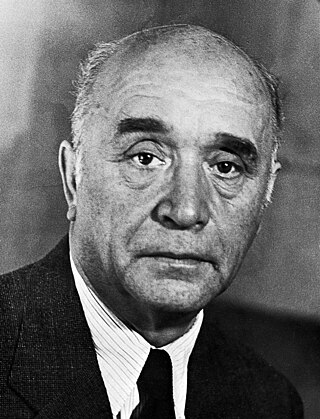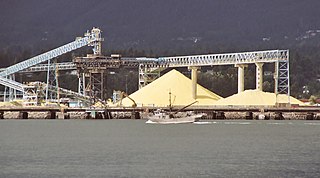Related Research Articles

CarlFriedrich Benz was a German engine designer and automotive engineer. His Benz Patent Motorcar from 1885 is considered the first practical modern automobile and first car put into series production. He received a patent for the motorcar in 1886, the same year he first publicly drove the Benz Patent-Motorwagen.

Sulfur (also spelled sulphur in British English) is a chemical element with the symbol S and atomic number 16. It is abundant, multivalent and nonmetallic. Under normal conditions, sulfur atoms form cyclic octatomic molecules with a chemical formula S8. Elemental sulfur is a bright yellow, crystalline solid at room temperature.

A match is a tool for starting a fire. Typically, matches are made of small wooden sticks or stiff paper. One end is coated with a material that can be ignited by friction generated by striking the match against a suitable surface. Wooden matches are packaged in matchboxes, and paper matches are partially cut into rows and stapled into matchbooks. The coated end of a match, known as the match "head", consists of a bead of active ingredients and binder, often colored for easier inspection. There are two main types of matches: safety matches, which can be struck only against a specially prepared surface, and strike-anywhere matches, for which any suitably frictional surface can be used.

Hydrogen sulfide is a chemical compound with the formula H2S. It is a colorless chalcogen-hydride gas, and is poisonous, corrosive, and flammable, with trace amounts in ambient atmosphere having a characteristic foul odor of rotten eggs. The underground mine gas term for foul-smelling hydrogen sulfide-rich gas mixtures is stinkdamp. Swedish chemist Carl Wilhelm Scheele is credited with having discovered the chemical composition of purified hydrogen sulfide in 1777. The British English spelling of this compound is hydrogen sulphide, a spelling no longer recommended by the Royal Society of Chemistry or the International Union of Pure and Applied Chemistry.

Fritz Haber was a German chemist who received the Nobel Prize in Chemistry in 1918 for his invention of the Haber–Bosch process, a method used in industry to synthesize ammonia from nitrogen gas and hydrogen gas. This invention is important for the large-scale synthesis of fertilisers and explosives. It is estimated that one-third of annual global food production uses ammonia from the Haber–Bosch process, and that this supports nearly half of the world's population. Haber, along with Max Born, proposed the Born–Haber cycle as a method for evaluating the lattice energy of an ionic solid.

Friedrich Karl Rudolf Bergius was a German chemist known for the Bergius process for producing synthetic fuel from coal, Nobel Prize in Chemistry in recognition of contributions to the invention and development of chemical high-pressure methods. Having worked with IG Farben during World War II, his citizenship came into question following the war, causing him to ultimately flee to Argentina, where he acted as adviser to the Ministry of Industry.
The year 1885 in science and technology involved some significant events, listed below.
The year 1818 in science and technology involved some significant events, listed below.
The year 1883 in science and technology involved some significant events, listed below.

Bertha Benz was a German automotive pioneer. She was the business partner and wife of automobile inventor Carl Benz. On 5 August 1888, she was the first person to drive an internal-combustion-engined automobile over a long distance, field testing the Benz Patent-Motorwagen, inventing brake lining and solving several practical issues during the journey of 105 km. In doing so, she brought the Patent-Motorwagen worldwide attention and got the company its first sales.
The Leblanc process was an early industrial process for making soda ash used throughout the 19th century, named after its inventor, Nicolas Leblanc. It involved two stages: making sodium sulfate from sodium chloride, followed by reacting the sodium sulfate with coal and calcium carbonate to make sodium carbonate. The process gradually became obsolete after the development of the Solvay process.

The Frasch process is a method to extract sulfur from underground deposits by taking advantage of low melting point of sulfur. It is the only industrial method of recovering sulfur from elemental deposits. Most of the world's sulfur was obtained this way until the late 20th century, when sulfur recovered from petroleum and gas sources became more commonplace.

The Claus process is the most significant gas desulfurizing process, recovering elemental sulfur from gaseous hydrogen sulfide. First patented in 1883 by the chemist Carl Friedrich Claus, the Claus process has become the industry standard.

Wilhelm Normann was a German chemist who introduced the hydrogenation of fats in 1901. This invention, protected by German patent 141,029 in 1902, had a profound influence on the production of margarine and vegetable shortening.

Hydrodesulfurization (HDS), also called hydrotreatment or hydrotreating, is a catalytic chemical process widely used to remove sulfur (S) from natural gas and from refined petroleum products, such as gasoline or petrol, jet fuel, kerosene, diesel fuel, and fuel oils. The purpose of removing the sulfur, and creating products such as ultra-low-sulfur diesel, is to reduce the sulfur dioxide emissions that result from using those fuels in automotive vehicles, aircraft, railroad locomotives, ships, gas or oil burning power plants, residential and industrial furnaces, and other forms of fuel combustion.
Claus is both a given name and a German, Danish, and Dutch surname. Notable people with the name include:
Karl or Carl Klaus or Claus may refer to:
Events in the year 1899 in Germany.

Marc Charles Sauria was a French chemist credited for inventing phosphorus-based matches in 1830–1831.
References
- ↑ Bibliographic Citation Sulfur Recovery Technology, B.G. Goar, American Institute of Chemical Engineers Spring National Meeting, New Orleans, Louisiana, April 6, 1986
- ↑ Ralf Steudel, Lorraine West, Vita of Carl Friedrich Claus (1827–1900) – inventor of the Claus Process for sulfur production from hydrogen sulfide. online-document from 2015 on ResearchGate.net. DOI: 10.13140/RG.2.1.1712.2644